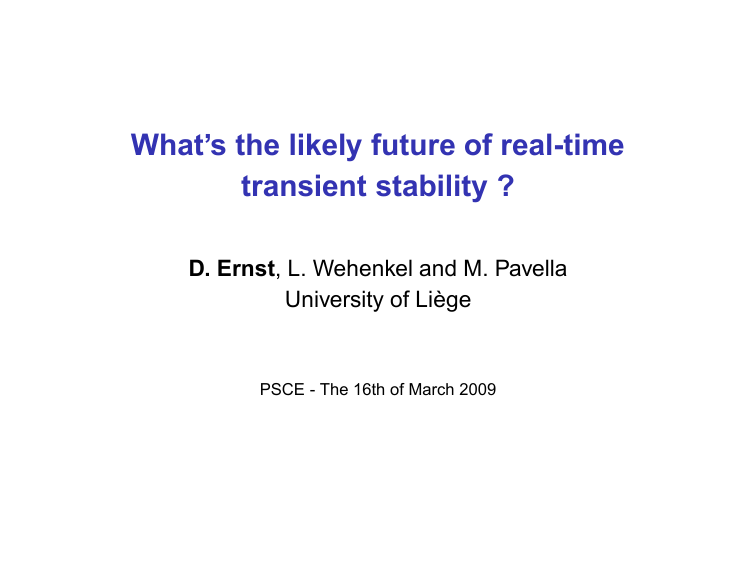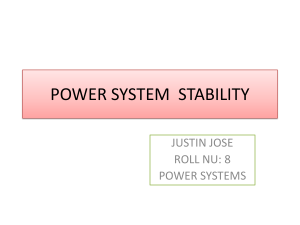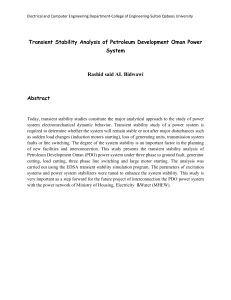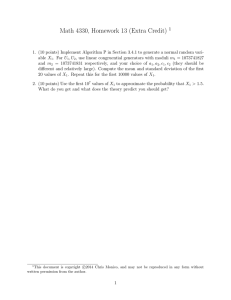What`s the likely future of real-time transient stability
advertisement

What’s the likely future of real-time transient stability ? D. Ernst, L. Wehenkel and M. Pavella University of Liège PSCE - The 16th of March 2009 What is transient stability ? Transient stability refers to the phenomena of loss of synchronism that may occur between the different (synchronous) generators of a power system in the aftermath of a large disturbance. When things go well after a disturbance: Disturbance ⇒ some generators speed up ⇒ their angles increase (with respect to the other generators) ⇒ their electrical power increases ⇒ they start slowing down When things turn nasty: Disturbance ⇒ some generators speed up ⇒ their angles increase ⇒ their electrical power decreases ⇒ they speed up again... the instability mechanism is born. Swing curves and loss of synchronism δ (deg) δ (deg) CMs CMs 125. 75. 100. 50. 75. 25. Time (s) 5. 50. 25. Time (s) -25. 0.0 1.25 -50. -25. 0.0 0.0 1. 2. 3. 4. -50. -75. Normal operating conditions Stressed operating conditions Power system: EPRI 88 machines test system. Disturbance: three-phase short-circuit cleared by opening a transmission line. 3 Analysis of transient stability phenomena The basic analysis: a list of contingencies is given and one has to identify those that lead to loss of synchronism (YES/NO stability analyis). A bit more sophistication: to compute for every contingency of the list stability margins. Stability margins often expressed in terms of (critical clearing time − clearing time) or (maximum loading conditions − loading conditions). Why stability margins ? 1. To know how robust is the YES/NO stability analysis with respect to changing operating conditions, other contingencies, the model of the power system. 2. Information for computing control actions (mainly to alleviate computational burdens). 4 Simulation of the power system dynamics as analysis tool How does it work ? For every contingency, simulate the power system dynamics over a few seconds. If the maximum angular deviation gets greater than a threshold value ⇒ unstable case. Simulation methods give an immediate YES/NO diagnostic of instability and are considered as accuracy benchmark. Can be used to compute stability margins (e.g., dichotomy search of the critical clearing time). What is needed to build/use this tool: an appropriate model of the system, a time-domain simulator and CPU time. 5 About reducing this CPU time for analysis • Vast majority of the research papers in transient stability ! • Most of the works have tried to obtain an accurate stability analysis while spending a minimum amount of time to simulate the system (whatever the brain power ;) ) • Several families of approaches: 1. Using the Lyapunov second theorem or its ”variants” (a great (and large) body of work but ... (answer later)). 2. Piloting the simulations in a ’clever’ way (sometimes by using some Lyapunov concepts (e.g., SIME)). 3. Using various heuristics to carry out stability analyses by simulating the system only over on a short-period of time and/or using simplified models. 4. Machine learning methods: analyze quite a few scenarios (a scenario: operating conditions, disturbance, etc) to build a model to predict the stability of “any” scenario. 6 The Lyapunov second theorem... (1892) Consider a nonlinear dynamical system ẋ = f (x (t)). Consider a function V (x ) : Rn → R such that: V (x ) ≥ 0 with equality if and only if x = 0 V̇ (x (t)) < 0 Then V (x ) is called a Lyapunov function candidate and the system is asymptotically stable. 7 .. and how they have used it (1960 → today) 8 What is really left from all these works to reduce CPU times ? Vast majority of the methods proposed to reduce CPU times for analyses have not moved from research laboratories to the real world. Why ? Some suggestions: 1. Is it because power systems are relatively immune to loss of synchronism ? 2. Is it because they do not work ? 3. Is it because power system engineers are happy with only standard time-domain software to analyze loss of synchronism phenomena ? 9 Transient stability and control Two classical objectives: 1. To decrease the likelihood of loss of synchronism phenomena (vastly studied). 2. To mitigate their effects when they occur. Possible actions: 1. Investments in infrastructure (transmission lines, FACTS, generators, ...). 2. Development of system protection schemes (e.g., islanding, generation shedding, dynamic breaking, . . . ) for emergency control. 3. Actions taken in control centres (e.g., generation rescheduling, changing the topology of the system, . . .). The constraints: Technical (especially for SPS) and financial (may be an objective too). 10 Why control requires a little more than simulations... A basic approach for control: Let U be the set of all control strategies. Let C be a set of “contingencies + operating conditions”. Run for every element of U × C a time-domain simulation to identify ’the best’ element in U. Why is this basic approach facing some problems ? 1. U is too large (e.g., for generation rescheduling with 100 machines and 10 production levels per machine → |U| = 10100 ). 2. Emergency control: huge CPU time constraints, lack of data for running simulations. 11 Beyond only simulations Importance sampling methods. Main idea: at every iteration, generate a subset of U by using the current sampling distribution; evaluate them by running simulations and define a new sampling distribution that ’targets’ the best samples. Successes for designing SPSs. Model predictive control. Main idea: solving an optimisation problem for which the trajectories are also considered as optimisation variables and for which the system dynamics are represented by constraints on the problem. Elegant (similarities with OPFs, . . . ) but optimisation problem non-convex. Lyapunov-type techniques. Provide information about instability mechanisms that may be invaluable for control. Successes have been reported (e.g., generation rescheduling with SIME+OPF, . . .). 12 Transient stability and the changing power systems Some major changes: 1. Dispersed generation subsystems 2. Power electronics (HVDC, phase shifters, . . .) 3. New interconnections How do these changes affect loss of synchronism phenomena ? What are the challenges they raise in terms of research ? 13 Dispersed generation subsystems • Most works in transient stability focus on evaluating whether/ensuring that every generator of the power system is able to maintain synchronism with respect to the others in the aftermath of a disturbance. • Before this conservative approach was probably meaningful but not now anymore. One can afford to lose a few ’small’ generators. ⇒ Need to study the mechanisms driving the propagation of loss of synchronism over longer time-periods, rather than only focusing on the inception/non-inception of such phenomena. 14 An illustration The transmission network is a grid of dimensions n × n. Over and under speed protections on the generators. How does n influence loss of synchronism phenomena ? 15 t=34.6sec Speed deviation Speed deviation t=10sec 1 0 −1 10 5 y 10 1 0 −1 10 5 y 5 0 0 x 1 0 −1 10 5 y 10 5 0 0 x t=35.195sec Speed deviation Speed deviation t=34.67sec 10 5 0 0 x 1 0 −1 10 5 y 10 5 0 0 x 16 t=20sec Speed deviation Speed deviation t=10sec 1 0 −1 15 10 5 y 0 0 5 10 15 1 0 −1 15 10 5 y x 1 0 −1 15 10 5 y 0 0 5 10 15 x t=60sec Speed deviation Speed deviation t=40sec 0 0 5 10 x 15 1 0 −1 15 10 5 y 0 0 5 10 15 x 17 HVDC and transient stability • “Synchronizing power” between two generators roughly inversely proportional to the “impedance between them”. • Installing a new AC line is increasing the “synchronizing power”. Not necessarily the case anymore when a HVDC link is installed. ⇒ May lead to systems with less and less “synchronizing power” and more likely to suffer from loss of synchronism phenomena. Challenge: How to operate HVDC links to increase transient stability margins ? 18 Four things to remember from this talk 1. Use pure time-domain methods for carrying transient stability analysis (together with some techniques for extracting information from the trajectories). 2. For control pure time-domain methods are not (and will probably never be) sufficient ⇒ many open research questions. 3. Rethink the definition of transient stability/instability. 4. HVDC links and transient stability: great dangers and great opportunities. 19



